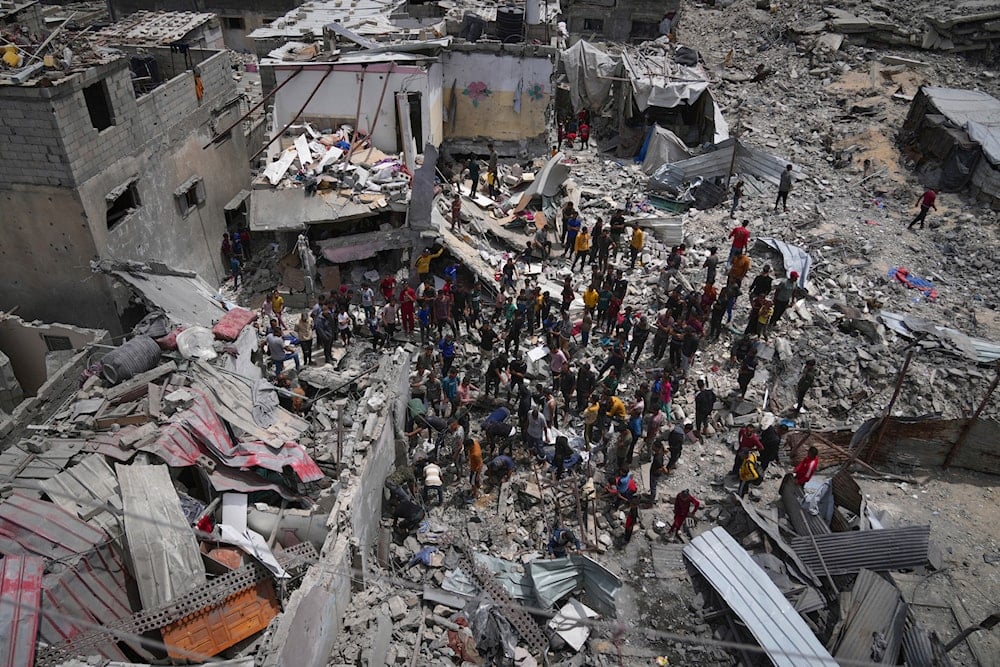Al Mayadeen obtains Hamas, other factions' response to US proposal
A proposed Gaza ceasefire framework includes a 60-day truce, phased Israeli captive release, humanitarian aid entry, Israeli military withdrawal, and reconstruction plans.
-

Palestinians search the rubble of a house targeted by an Israeli army strike that killed at least five people in Khan Younis, in the southern Gaza Strip, on May 1, 2025 (AP)
Hamas has presented a detailed framework on Saturday for a permanent ceasefire in the Gaza Strip, proposing a 60-day truce during which US President Donald Trump would act as guarantor to ensure "Israel’s" compliance.
According to the document, the plan, mediated by US Special Envoy Steve Witkoff, aims to pave the way toward a comprehensive resolution to the aggression on Gaza.
Under the proposal, 10 living Israeli captives would be released in the following stages:
- Day 1: 4 captives
- Day 30: 2 captives
- Day 60: 4 captives
Additionally, the bodies of 18 dead captives would be returned as follows:
- Day 10: 6 bodies
- Day 30: 6 bodies
- Day 50: 6 bodies
In exchange, "Israel" would release an agreed-upon number of Palestinian prisoners and detainees and abide by each phase.
Humanitarian, reconstruction provisions
The framework includes the immediate entry of humanitarian aid, in line with the January 19, 2025, protocol, and mandates the rehabilitation of essential infrastructure, electricity, water, sanitation, telecommunications, and roads.
Key elements include:
- Restoration of hospitals, health centers, schools, and bakeries
- Free travel for Gaza residents through the Rafah crossing
- Resumption of commercial activity
- Reconstruction plan to be implemented over 3–5 years, supervised by Egypt, Qatar, the UN, and others
- Israeli military withdrawal and cessation of military operations
All Israeli military operations would cease immediately upon the implementation of the agreement. Additionally, aerial activity, including reconnaissance, would pause for 10 hours daily and extend to 12 hours on days when an exchange is taking place.
Following the release of the first group of captives, Israeli forces would withdraw to pre-March 2, 2025, positions, as per maps included in the January 19 agreement.
Governance, post-war planning
The framework proposes that a technocratic committee assume administrative responsibilities in Gaza during the post-ceasefire transition. Additionally, long-term governance and stability would be part of broader negotiations to be launched on Day 1 of the ceasefire.
Topics for negotiation include:
- Terms for releasing all remaining Israeli captives
- Declaration of a permanent ceasefire
- Full Israeli withdrawal from Gaza
- A long-term cessation of hostilities (5–7 years) guaranteed by the US, Egypt, and Qatar
US-led mediation, international oversight
The framework identifies the US, Egypt, and Qatar as international guarantors for the ceasefire, prisoner exchange, aid access, and follow-up negotiations.
Moreover, Witkoff will travel to the region to lead mediation efforts, while President Trump will personally announce the agreement and reaffirm Washington’s commitment to a final resolution.
Both parties will also:
- Exchange information on prisoners and detainees by Day 10
- Commit to humane treatment of all prisoners in line with international law
- Final exchanges of all remaining captives and remains (from the reported list of 58) would occur after a permanent ceasefire is reached and full Israeli withdrawal is completed
Palestinian Resistance factions address Palestinians
No real ceasefire offer amid ongoing Israeli aggression
Meanwhile, Palestinian Resistance factions issued a statement on Saturday rejecting what they described as misleading proposals for a ceasefire, saying none genuinely aim to stop the massacres of civilians amid ongoing Israeli aggression on the Gaza Strip.
The factions emphasized that all initiatives presented so far have effectively legitimized the continuation of the killing machine, demanding that the Palestinian people accept them without any guarantees for their basic rights.
They stated that they had seriously examined all proposals, including the January 19 agreement, which the occupation forces later reneged on by escalating their aggression.
Factions outline demands for truce and recovery
The statement reaffirmed that Resistance factions are not closing the door to international or regional efforts to halt the aggression and stop the bloodshed. However, they clarified that any agreement must be based on a clear formula that guarantees the lives, dignity, and rights of the Palestinian people.
Their demands include:
- The unconditional flow of humanitarian aid
- Commencement of reconstruction in the Gaza Strip
- Full withdrawal of the occupation forces from Gaza
- Return of displaced Palestinians to their homes
The factions stressed that only such a framework can alleviate the suffering of the population and lay the groundwork for stability.
Initiative for national leadership
The factions revealed they are working on an initiative to halt the famine, provide emergency shelter, and stop the ongoing genocide. This initiative also aims to:
- Establish a temporary and acceptable national leadership to manage Gaza during truce periods
- Ensure stability and administrative continuity
- Create a political opening that restores hope to the Palestinian people
The statement concluded by affirming the factions' commitment to constantly striving to achieve what preserves the dignity, humanity, and future of the Palestinian people.

 5 Min Read
5 Min Read










